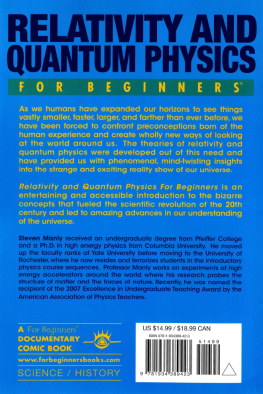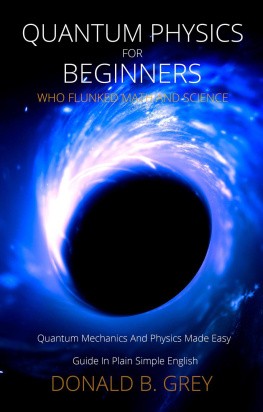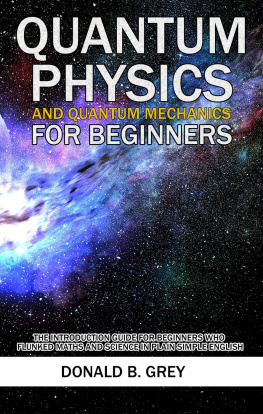QUANTUM
PHYSICS
FOR BEGINNERS
Discover The Science of Quantum Mechanics and Hidden Secrets of the Universe
James
Goldstein
Copyright 2020 James Goldstein
All rights reserved.
It is not legal to reproduce, duplicate, or transmit any part of this document by either electronic means or in printed format. Recording of this publication is strictly prohibited
Disclaimer
The information in this book is based on personal experience and anecdotal evidence. Although the author has made every attempt to achieve an accuracy of the information gathered in this book, they make no representation or warranties concerning the accuracy or completeness of the contents of this book. Your circumstances may not be suited to some illustrations in this book.
The author disclaims any liability arising directly or indirectly from the use of this book. Readers are encouraged to seek accounting, legal, or professional help when required.
This guide is for informational purposes only, and the author does not accept any responsibilities for any liabilities resulting from the use of this information. While every attempt has been made to verify the information provided here, the author cannot assume any responsibility for errors, inaccuracies, or omission.
Contents
INTRODUCTION
Max Planck was a German physicist regarded as the founder and originator of quantum mechanics. During the year 1900, he introduced the idea of quantized energy. There were conflicting issues about quantum physics and gravity. Still, they constituted no barriers for the contemporary world since the creed and paraphernalia of common relativity, and quantum physics could be applied to different categories of human problems.
However, during the period and age of Planck, the large was little, meaning an identifiable marriage between both phenomena. The union of these two enigmas has continued to elude humanity. No one could confidently state over time the behavior of the world, including the adored theories and rules of physics.
There is anticipation that by the end of the Planck period, gravity disconnected from the other integrated forces of nature, gaining independence and becoming unique to be described in these present days theories. With the aging of the earth, the ideologies continued to grow and expand, neutralizing all energy concentrations. Therefore, it leaves the remnants of these forceful and cohesive integrations into weak electrons and strong nuclear forces.
Following that trend, the weak forces of electron disintegrate into electromagnetic and weak nuclear forces that expose the four known unique forces. The greater power binds the nucleus of an atom while the weaker power controls radioactive decay. Also, the power of electromagnetism holds molecules while the force of gravity holds together bulk matter.
With all these, matter interplays as subatomic elements, including energy in the form of photons. These are containers of light energy manifesting as waves just like they are particles. The heat in the world causes these photons to convert their energies into matter or antimatter particles suddenly. In a short time, this will be destroyed and reconvert their energy into photons. Antimatter is a real phenomenon that looks like matter but carries an opposite electrical charge.
This book will help you in comprehending the interplay of these particles and elements in nature and the corresponding theories and laws that established them.
CHAPTER ONE
WHAT IS WAVE FUNCTION?
Wave Function in Nature
The symbol of this phenomenon is the psi, which is a Greek letter that could be represented with the capital letter or small letter , respectively. In quantum physics, it is an arithmetical picture of the small state of a secluded quantum system.
It is prospective amplitude with a complex system, including the likelihood of possible measurements made and derivable from it. It features some levels of independence equivalent to some higher levels of transforming observables. With this description, the tiny state can help us in deriving this function.
The charge of a wave function of an element at a specific position of space and time is connected to the chances of the unit remaining constant at a particular time. In explaining the term using sound effects, a wave function is shown as the amplitude of the wave-particle known as de Broglie wave.
Sound Wave Effects
In considering this kind of effect, the amplitude is not important. When a wave effect is squared or doubled, it becomes significant physically. The prospect of discovering the particle stated by a specific wave effect at a particular angle and period is comparative to the charge of the squared wave function.
Albert Einstein assumed and put forward the comparativeness between the frequency (f) of a photon and the corresponding energy (E) in 1905, where E= hf . This also includes the equivalent correlation of the force of a photon (p) and the corresponding wavelength.
Understanding Schrdinger Equation
In 1925, Erwin Schrdinger proposed the equation but made it available in 1926, and it was credited to his name. This is regarded as the Schrdinger equation but follows the usual handling of energy with quantum operators, including de Broglie dealings. However, the resolutions of the equations are the wave effects for the quantum unit. This equation became the beginning for the improvement of quantum physics, and it was the project the earned Schrdinger the award of Nobel Prize in Physics in 1933.
But the explanation and analysis of this equation was difficult initially. Schrdinger and other physicists decided that wave effects indicate particles scattered where many of the elements are located at the spot with the largest wave function. This analogy is not attuned with the flexible dispersion of a wave packet, which shows particles away from a target; rather, they spread out or scatter in different directions. If a particle scatters, it may not scatter or spread in any other angle and does not split and run in many directions.
However, the outlook of possibility amplitude was given by Born in 1926 and relates the estimations of quantum physics to the probabilities of scientific experiments. This is also acknowledged as a branch of the interpretations of Copenhagen about quantum mechanics. Although there are other analyses and explanations of quantum physics, Fock and Hartree attempted to resolve the wave effect of N-body. They developed the cycle of self-consistency, which is used as an algorithm that approximates the solution, regarded as the Hartree-Fock system and methodology. relative
Schrdinger discarded the wave effect equation that meets the requirements of relativistic power conservation, as it envisaged downbeat energies and probabilities. However, he made available the non-relativistic one. But Fock, Klein, and Gordon discovered the Lorentz variant in 1927, which is a better equation, and included electromagnetic interaction.
On the same vein, in 1928, De Broglie reached the same conclusion and discovered a similar equation. Therefore, the new name or current description of this equation is the Klein-Gordon equation.
This equation comes in two forms:
Time-Dependent Schrdinger Equation (TDSE)
This equation describes that wave effects can evolve into standing waves. This is also regarded as stationary states. These conditions make it easy to solve any equation for wave condition. The time-dependent Schrdinger equation depends on physical circumstances and defines a system that grows with time.













